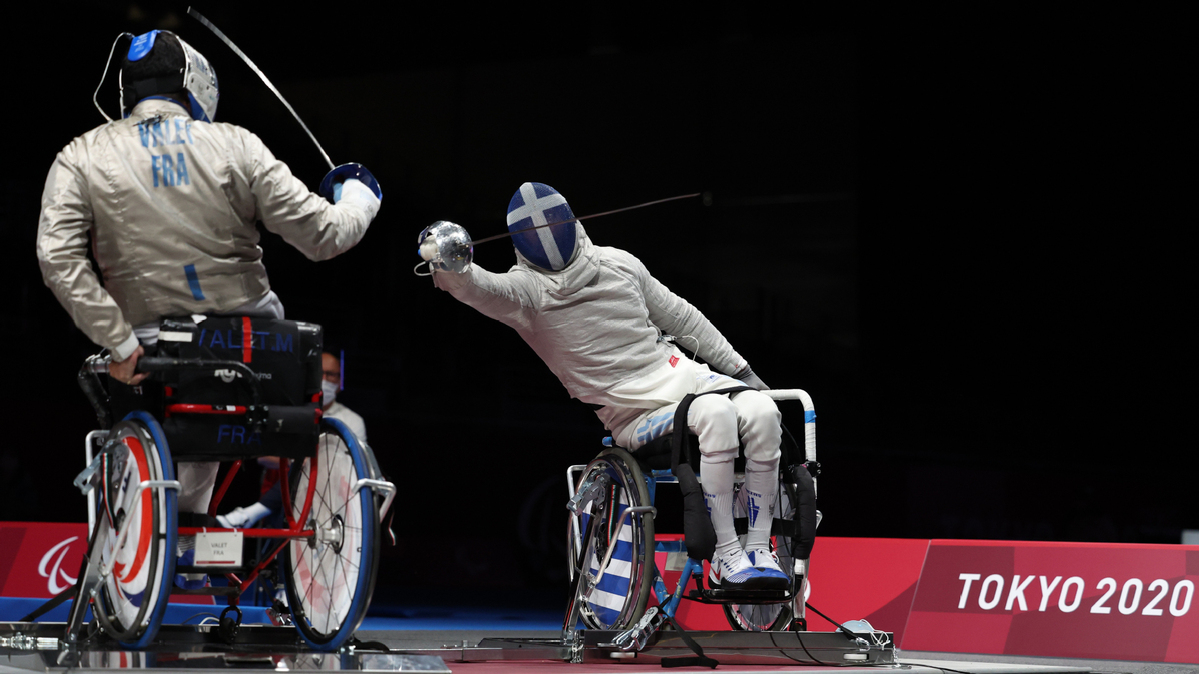科普:残奥会运动员如何分级?盲人选手怎么踢球? Understanding the Paralympic Games: impairment classifications in Para sport
中国日报网 2021-08-26 08:00

东京残奥会正在如火如荼地进行,本届残奥会共分22个大项,539个小项,共有来自约160个国家和地区的4400名运动员参赛。
为保证比赛尽可能公平、公正和安全,国际残奥委会对参赛选手的残疾情况和运动能力进行评级,根据具体参赛项目的要求将残疾程度、运动能力差不多的选手分在一起进行比赛。

Eligible impairments
符合残疾标准
The first component of the Paralympic classification is identifying the eligible impairments. In order to participate in the Paralympic Games, Para athletes must have at least one of the following ten impairments as outlined by the International Paralympic Committee:
残奥会运动员分级的第一个要求是符合残疾标准。参加残奥会的残疾人运动员必须至少有国际残奥委员会规定的以下十种残障之一:
Impaired muscle power
肌力受损
Impaired passive range of movement
被动活动范围受损
(注:物理医学与康复名词,由外力使关节活动时所通过的运动弧)
Limb deficiency
肢体残缺
Leg length difference
双下肢不等长
Short stature
矮小症
Hypertonia (excessive muscle tone in arms or legs that lead to difficulty in movement)
张力过强(手臂或腿部肌肉张力过大,导致运动困难)
Ataxia (a disorder of the nervous system affecting coordination, balance and speech)
共济失调(一种影响协调、平衡和语言功能的神经系统紊乱)
Athetosis (movement dysfunction such as involuntary writhing of the limbs)
手足徐动症(运动功能障碍,如四肢不自主扭动)
Vision impairment
视力障碍
Intellectual impairment
智力障碍
Some events, like the football 5-a-side or goalball, are only open to athletes who have a vision impairment. Other sports like swimming are open to athletes with any of the 10 impairments.
部分项目,如残奥会5人制足球或门球只允许视力障碍运动员参加。游泳等其他运动项目允许符合上述10种残疾状况中任意一种的运动员参加。
【残奥小百科】
残奥会5人制足球(football 5-a-side)比赛是以攻破对方球门得分为目的而进行的同场攻守对抗项目。每队由5名场上队员和5名替补队员组成,其中包括守门员和替补守门员各1名。除守门员外,其他队员都为盲人。只有守门员可以在规定的区域内用手触球。比赛中,进攻方目标是把球踢进对方球门得分,而防守方则是尽力阻止对方得分。比赛用球由皮革或特殊的合成材料制成,它有一个内部发声设备,能让运动员听见它的运动。
盲人门球(goalball)比赛在两队之间进行,每队由3名球员和最多不超过3名的替补队员组成。运动员比赛都要戴上眼罩。比赛在体育馆内光滑的地板上举行,使用带有响铃的球,双方要把球滚过对方的球门线。如果对手阻止了进攻,就进行攻防转换。

Sport classes
体育项目分级
The second component of classification is determining how much an impairment affects the performance of each athlete. Because the severity of these conditions vary from person to person, this secondary classification system is used so that athletes will be grouped with competitors who have similar degrees of impairment, thus minimizing unfair disadvantages.
残奥会运动员分级的第二个标准是确定一种身体障碍对运动员的表现有多大影响。由于这些残疾情况的严重程度因人而异,因此残奥会采用了这种二级分类系统,以便将具有相近残障程度的运动员归为一组,从而最大限度地保证公平。
Visually impaired athletes, for instance, are divided into three different classes (B1, B2 or B3) based on the clarity of their vision and degree of light perception. Football 5-a-side is limited to athletes who meet the criteria of the B1 sport class, where they have a very low level of clarity and/or no light perception. Goalball, on the other hand, is open to visually impaired athletes of all three classes, but requires all players to wear eye shades when competing.
例如,视障运动员根据其视力的清晰度和光感程度被分为三个不同的等级(B1、B2或B3)。5人制足球仅限满足B1级别标准的运动员参赛。B1级别运动员的视力清晰度非常低,且/或无光感。而门球对所有三个级别的视障运动员开放,但要求所有运动员在比赛时戴上眼罩。
Other sports like athletics, which are open to athletes with any of the ten impairments, will feature even more classes to include athletes from every category as well as different degrees of impairment. Each of the classes under every category will have its own medal event.
其他体育项目,如田径项目面向有上述10种残疾的运动员,将分为更多小项,从而将各种残疾以及残障程度不同的运动员包含在内。各项目类别下的每个级别小项都设有奖牌。
In some respects, these sport classes can be likened to the weight classes in boxing and judo at the Olympic Games. Just like different weight categories help determine level of fairness in tournaments, the sport classes ensure that the athletes' strength and tactical ability, rather than their physical characteristics, are highlighted during the competition.
在某些方面,残奥会体育项目分级与奥运会拳击和柔道的重量分级类似。正如划分不同重量级别有助于确保比赛公平一样,体育项目分级确保在比赛中突出运动员的技术和战术,而不是他们的身体条件。
Through this system, the Paralympics can maximize the number of participants, break down barriers and award recognition to athletes based on their extraordinary levels of skill, endurance and mental focus.
通过这个系统,可以最大限度地让更多运动员参加残奥会,打破壁垒,并根据运动员非凡的技术水平、耐力和精神专注度给予他们认可。
来源:Timeout
编辑:董静

















 英语点津微信
英语点津微信 双语小程序
双语小程序